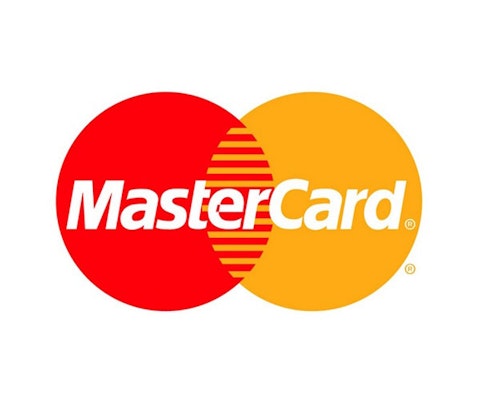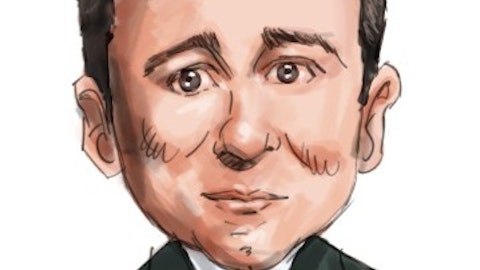Last year, Chuck Akre’s Akre Focus Fund beat the S&P 500 by over 15%. A value-oriented investor, we look to Akre for undervalued investment ideas. And based on his top holdings, he favors the large credit card companies, discount retailers, and boutique broker-dealers.
Mastercard (NYSE: MA) is 8.3% of the portfolio and Visa (NYSE: V) is 3.9% of the portfolio. “It’s a phenomenal business,” commented Akre on MA in an interview with CNBC. He commented that electronic transactions “are still a relatively small percentage of transactions. Roughly 85% of all transactions are still done with paper.” We have long been a fan of credit card transaction processors. And with increasing mobile functionality, there are now huge opportunities for MA and V to enter into the lucrative mobile payments market. With its collaboration with Google Wallet/Isis, Visa is well-positioned to capitalize on technological advancements being made. Visa has plans to launch V.me in Europe this year, which will lead to a boost in transaction volumes. Until MA settles the merchant litigation lawsuit (September 2012 trial date), we are preferential to Visa.
Ross Stores (NASDAQ: ROST) is 6.4% of the portfolio and The TJX Companies (NYSE: TJX) is 3.9% of the portfolio. Given slowing earnings momentum for both companies over the past two years, we are expecting SSS growth to tail off. Q1’s weather was favorable for SSS increases that beat guidance, but we fail to see additional catalysts for the companies. Also, as cotton prices decline after a peak in March of last year, we think this could shave off the benefit that discount retailers get in the full-priced segment. We see limited upside in either company with ROST trading at ~18.0x P/E and ~9.0x EV/EBITDA (five-year average of 15.0x), and TJX trading at ~17.0x P/E (14.0x average multiple) and ~8.0x EV/EBITDA.
American Tower (NYSE: AMT) is 5.8% of the portfolio. We like this worldwide provider of wireless and broadcast towers. For one, we characterize the tower model as very stable, complete with long-term contracts, rate escalators, low capex, high margins, and perhaps most importantly high barriers to entry. The 4G LTE rollouts will drive domestic lease volumes, as growth from overseas markets with more attractive lease-up opportunities. Moreover, now that AMT has announced a dividend, it can diversify its investor base. The annual dividend will be between $0.84 and $0.90 this year. AMT is the only investment grade tower company in the US and is not as levered compared to peers. While it trades at a premium to the other tower operators, we see potential catalysts like carrier investments, international expansion, and spectrum auctions as drivers of valuation.
Dollar Tree (NASDAQ: DLTR) is 4.7% of the portfolio. We see DLTR as riding a secular trend against the increasingly challenging macro environment that is well-positioned to make strides in market share. Management raised FY 2012 guidance to $4.74 to $4.94 from original $4.65 to $4.90 as it flowed through the $0.06 beat vs. guidance. Comps were down q-o-q, but were up 12.3% compared to the same period in 2010, which is a big growth number. If valuation came down to a more reasonable level we would be buyers given that we think the stock could trade in to the low $90s.
Moody’s (NYSE: MCO) is 4.7% of the portfolio. As one of the largest credit ratings agencies, MCO benefited from increased volume in USD and Euro-denominated investment grade issuance, sovereigns included. However, we would not expect those results to be replicated as high yield and investment grade issuance has been slowing. The company left FY 2012 guidance unchanged even after a strong Q1, suggesting that we are thinking along the same lines as management. Unless Europe sees stabilization in 2H 2012, we think the first half of the year’s growth will outpace the second half. Macro sentiment heavily influences bond issuances, so if the European countries see stabilization, there could be added ratings revenues in 2H 2012. MCO trades at ~13.0x 2012 earnings with comps like S&P owner, McGraw-Hill, trading at that same level but with the slower growth publishing business. Hence, we agree with Akre that there is potential for multiple expansion.
TD Ameritrade (NYSE: AMTD) is 4.6% of the portfolio. April results were mixed. Daily average revenue trades (DARTs) were 368K, down 3% m-o-m and down 9% y-o-y. Management commented on the macro instability negatively affected trading volume but caveated that activity in derivatives and options moved higher, which will benefit nicely when and if volumes see an uptick. Assets levels were stable at $451 billion, down slightly m-o-m from $452 billion. Management is confidant in AMTD’s asset gathering abilities, and we are inclined to agree. Hitting at the midpoint of the projected 7% to 11% organic growth rate should be doable. We like AMTD’s margin leverage and future asset gathering potential and identify upside opportunity albeit from a longer-term perspective.
LPL Investment Holdings (NASDAQ: LPLA) is 3.4% of the portfolio. LPLA is an independent broker-dealer with technology, clearing, custody and investment advisory services to independent, RIA advisors. After serious consolidation efforts, it is in the top ten broker-dealers by advisor volume but is now facing aggressive competitors. Shareholders in mid-May received a $2 per share special dividend, which when coupled with the $0.12 quarterly dividend made for compelling yield (~7% annualized). However, at ~17.0x 2012 earnings, we think the valuation is already pretty rich.
Lamar Advertising (NASDAQ: LAMR) is 2.9% of the portfolio. We are not quite as bullish on the third largest outdoor advertising company in the US with ~160,000 billboard displays. It has an 81%/19% local/national revenue and is a leader in digital billboards. For now, we would rather not be stockholders as volatility will likely increase as revenue growth slows. Q1 results were pretty good, beating consensus estimates, but as we alluded to earlier, we see revenue growth dropping in Q2 and Q3. Occupancy levels have somewhat recovered but the minimal price increases on the digital platform (2% to 5%) are down from double digits in 2010. Because it is a locally focused business in a challenging local business environment, we are concerned about future growth abilities.


